Humanoid robots in India present several potential risks related to privacy and surveillance. These risks stem from the advanced sensor technologies and AI capabilities integrated into these robots, which can collect and analyze vast amounts of personal data.
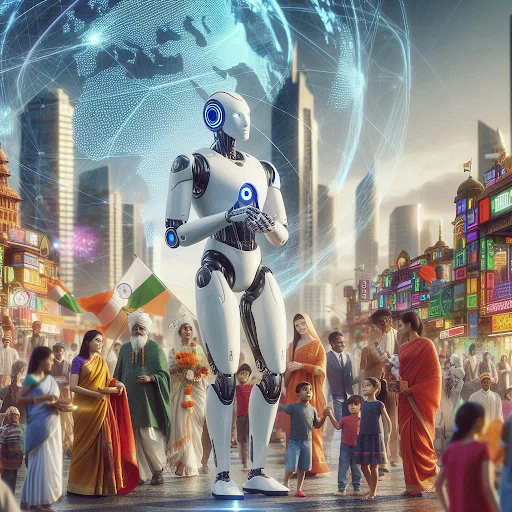
Potential Risks of Humanoid Robots in India
The deployment of humanoid robots in various sectors in India, such as healthcare, hospitality, and public safety, raises significant privacy and surveillance concerns. These robots are equipped with an array of sensors, cameras, microphones, and AI, enabling them to interact with their environment and gather data.
- Data Collection and Surveillance:
- Humanoid robots can collect extensive personal information, including facial features, voice data, location data, and behavioral patterns. This data collection can lead to privacy breaches, unauthorized access, and misuse of data.
- AI-driven surveillance technologies, including those used in humanoid robots, are expanding internationally, raising concerns in India, given its volatile neighborhood.
- Privacy Implications:
- The collection of sensitive personal data by robots can violate the right to privacy and liberties of individuals.
- The use of AI to improve cybersecurity is an important goal for India, but the same technology can be used for surveillance, raising concerns.
- Cybersecurity Risks:
- Humanoid robots are susceptible to hacking, which could lead to data breaches, system manipulation, or even the weaponization of the robot, compromising security operations.
- Ethical and Regulatory Challenges:
- The absence of clear legal frameworks regarding liability for robot actions and ethical guidelines for operation creates significant challenges.
- India needs robust frameworks to address issues like data privacy, robot rights, and accountability as robots become more autonomous.
- Surveillance and National Security:
- AI-driven autonomous robots and AI-powered drones, and spycraft can provide adversaries with powerful new weapons, raising justified alarm in India.
- The proliferation of tools with capabilities of collecting real-time information and the potential for their being used for spying by agencies and actors with malicious intent is a concern.
- Biometric Data Collection:
- The collection of biometric data, such as fingerprints and iris scans, from individuals raises privacy concerns, especially with the lack of a comprehensive data protection mechanism in place.
- Data Storage and Sharing:
- The long-term storage of biometric data and its potential sharing with other law enforcement agencies can create a surveillance state.
- AI Bias:
- AI models, if trained on imbalanced datasets, can exhibit biases that perpetuate societal inequalities or lead to discriminatory outcomes in automated decision-making.
These risks highlight the need for robust regulatory frameworks, ethical guidelines, and data protection measures to ensure the responsible deployment of humanoid robots in India.
Humanoid Robots in India
India has seen a rise in humanoid robot development across various sectors, from education and healthcare to customer service and space exploration. These robots are designed to mimic human form and behavior, utilizing advancements in AI, robotics, and machine learning.
Notable Humanoid Robots
- Manav(2014): India’s first 3D-printed humanoid robot, developed by A-SET Training and Research Institute. It is 2 feet tall, weighs 2 kilograms, and can perform various activities like walking, dancing, and playing football. It has 21 degrees of freedom and uses binocular vision processing.
It’s an open-source framework that encourages experimentation among students and researchers.
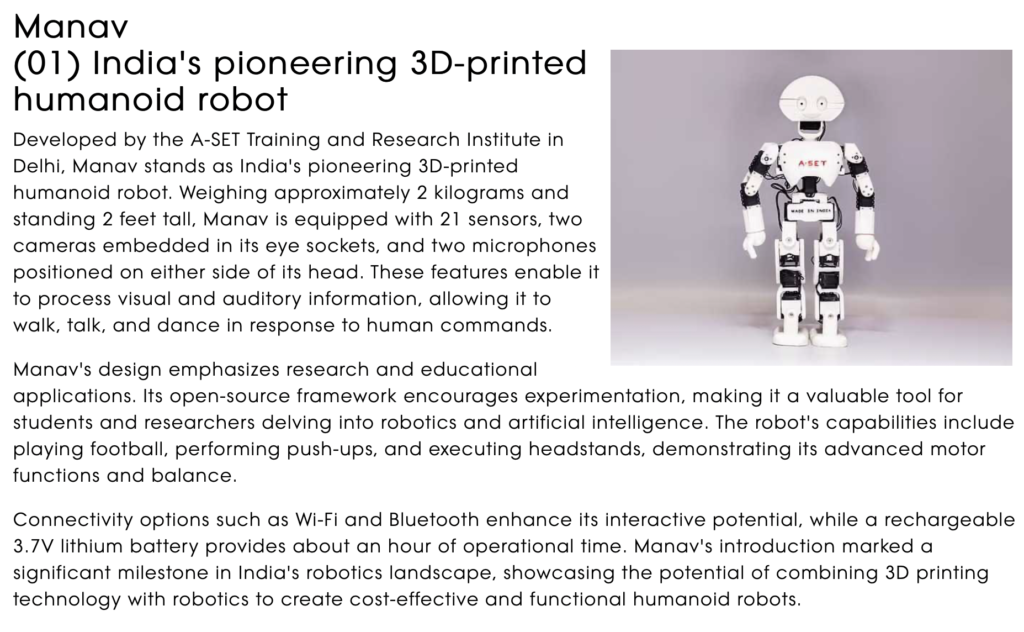
- Mitra (2017): Developed by Bengaluru-based Invento Robotics, Mitra gained prominence by greeting Prime Minister Narendra Modi and Ivanka Trump at the Global Entrepreneurship Summit. This 5-foot-tall robot is designed for customer service in retail, hospitality, and banking, featuring facial recognition, autonomous navigation, and multilingual communication via a touchscreen. Its success led to upgraded versions, Mitra 2 and Mitra 3, with enhanced facial recognition.
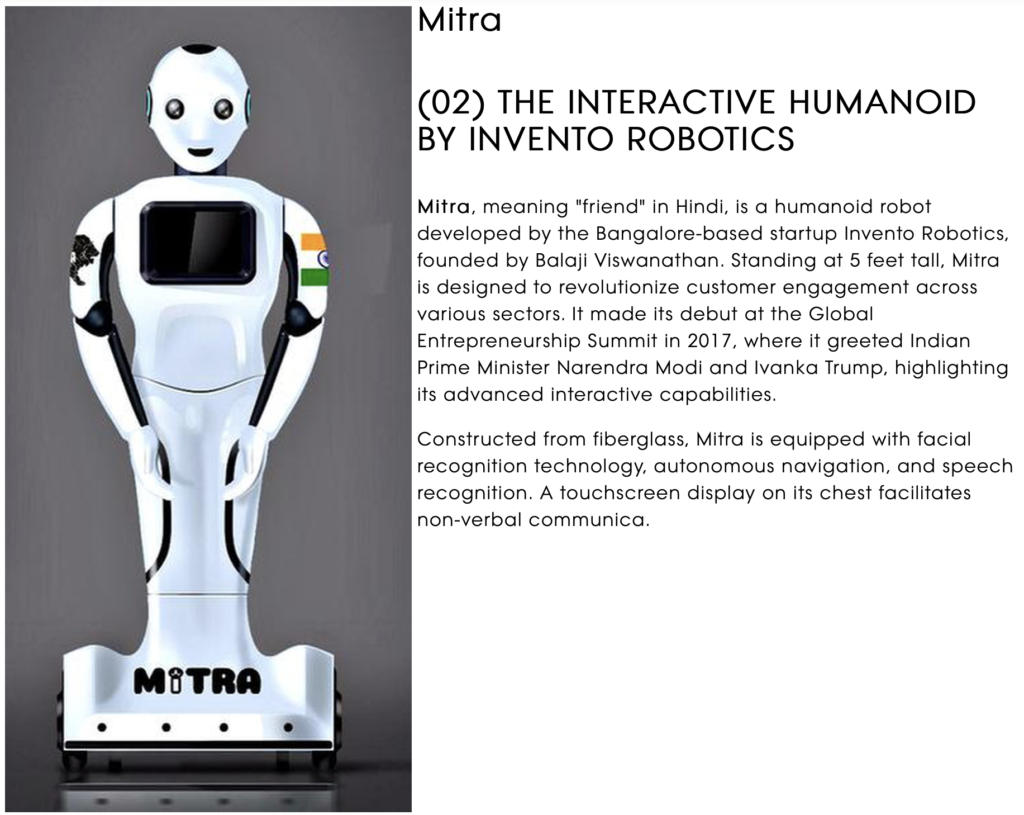
- KP Bot (2019): India’s first humanoid RoboCop, KP Bot, was developed by Asimov Robotics in collaboration with the Kerala Police’s Cyberdome unit. Standing 5.7 feet tall, it performs front office duties, identifies criminals using facial recognition, and can converse in multiple languages (Malayalam, Hindi, English). H-Bot Robotics also contributed to similar police robots.
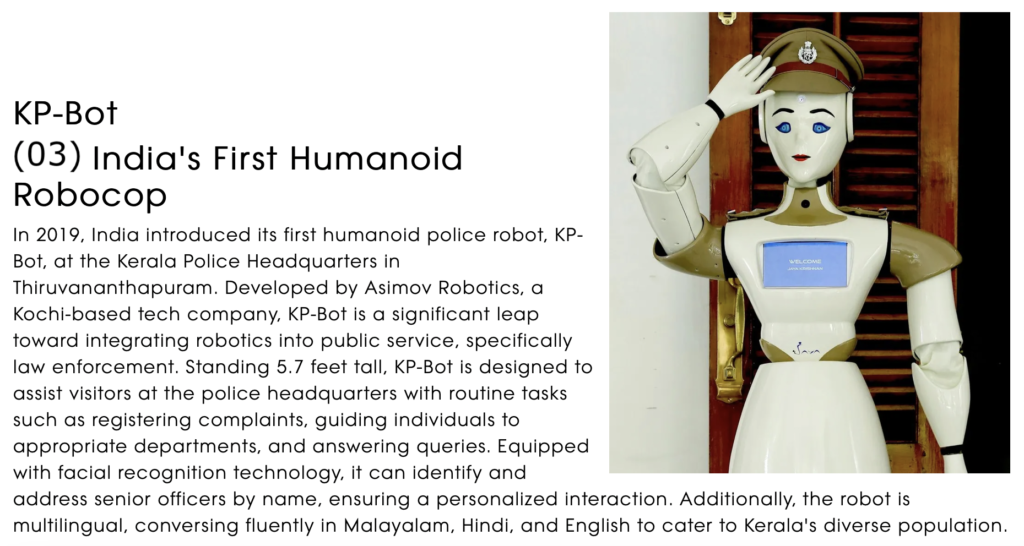
- INDRO (2016): Built by Santosh Hulawale, INDRO stands as India’s tallest humanoid robot at 2 meters. Constructed from low-cost materials, it can lift objects up to 2 kg and carry 150 kg, demonstrating affordability and functionality.
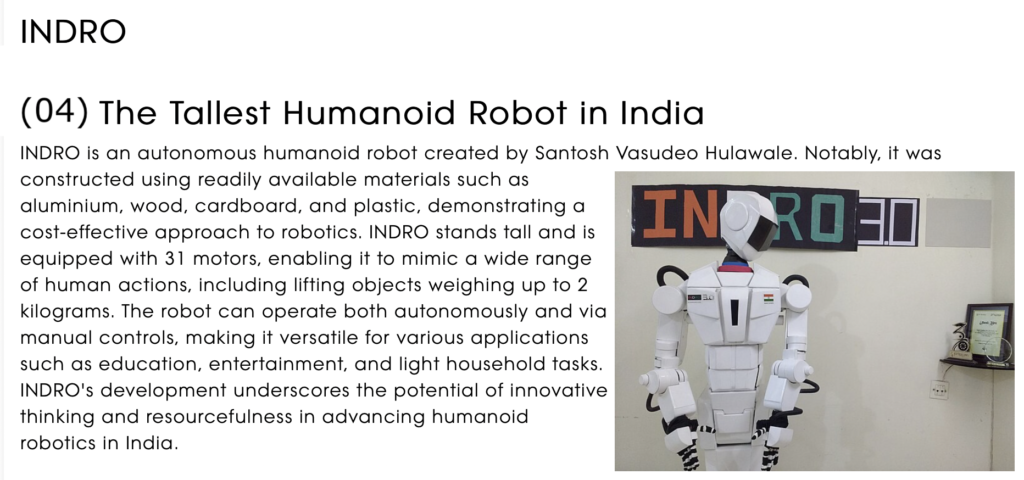
- Vyommitra (2024): Developed by the Indian Space Research Organisation (ISRO), Vyommitra is India’s first humanoid robot designed for space missions. It is a half-humanoid (without legs) capable of simulating human functions, monitoring systems, issuing alerts, and interacting with the spacecraft in both Hindi and English. Vyommitra is crucial for assisting astronauts and ensuring safety during the Gaganyaan Mission.

- RADA: An AI-based robot deployed at Delhi’s Indira Gandhi International Airport by Vistara to enhance customer service.
A humanoid robot developed by Vistara (a joint venture between Tata Sons and Singapore Airlines), RADA enhances customer service at Delhi’s Indira Gandhi International Airport. It provides flight information, assists with navigation, and engages passengers interactively.
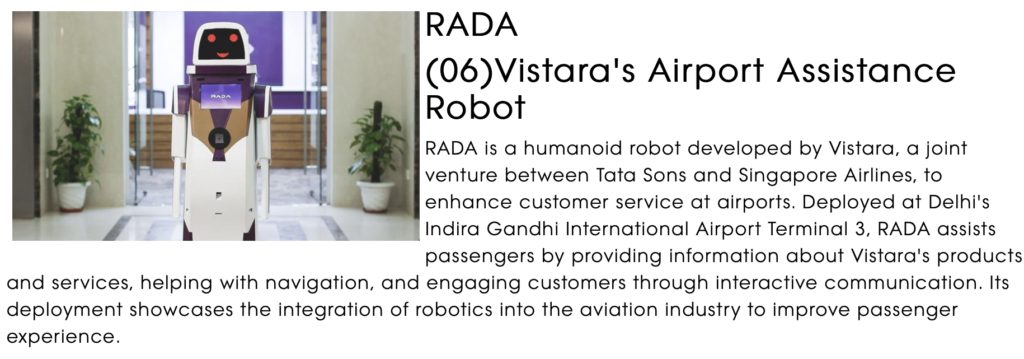
- KEMPA: A passenger-assistant humanoid robot found at Bengaluru airport, by Sirena Technologies, answers queries in both English and Kannada.
Created by Sirena Technologies in Bengaluru, KEMPA is designed to provide flight and check-in information at airports, indicating a focus on specialized customer service roles
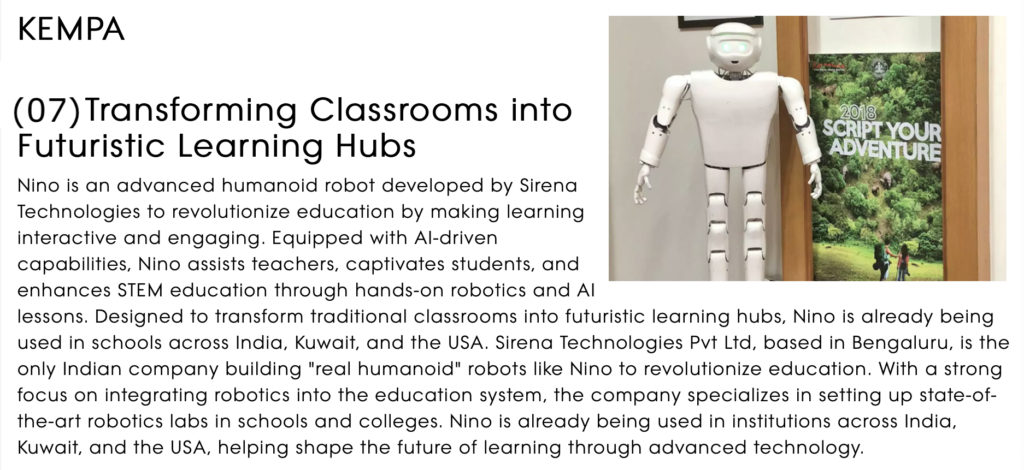
- IRA (Interactive Robotic Assistant): Deployed by HDFC Bank, IRA assists customers with banking queries, provides information, and guides them through branches using voice navigation. Developed in collaboration with Invento Makerspaces and Senseforth Technologies, IRA utilizes GPS-based indoor navigation, facial recognition, and speech recognition
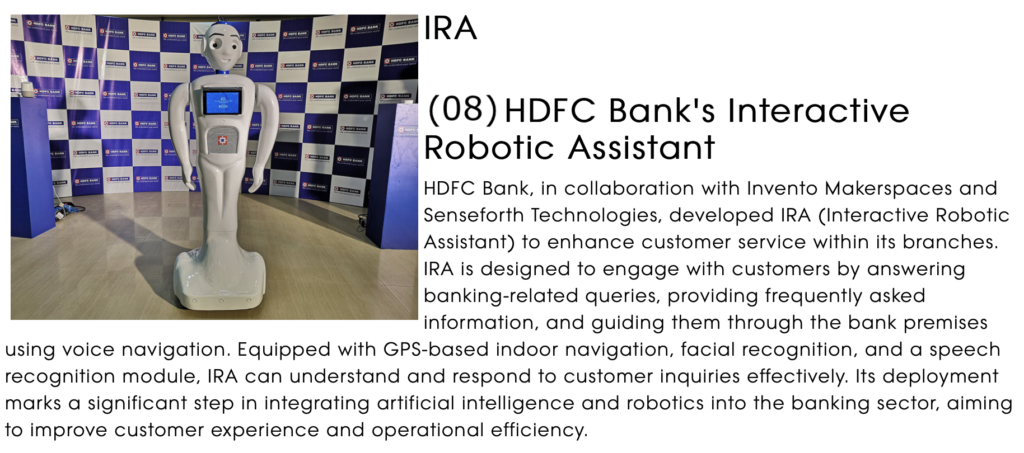
- Nino: An advanced humanoid robot developed by Sirena Technologies to revolutionize education.
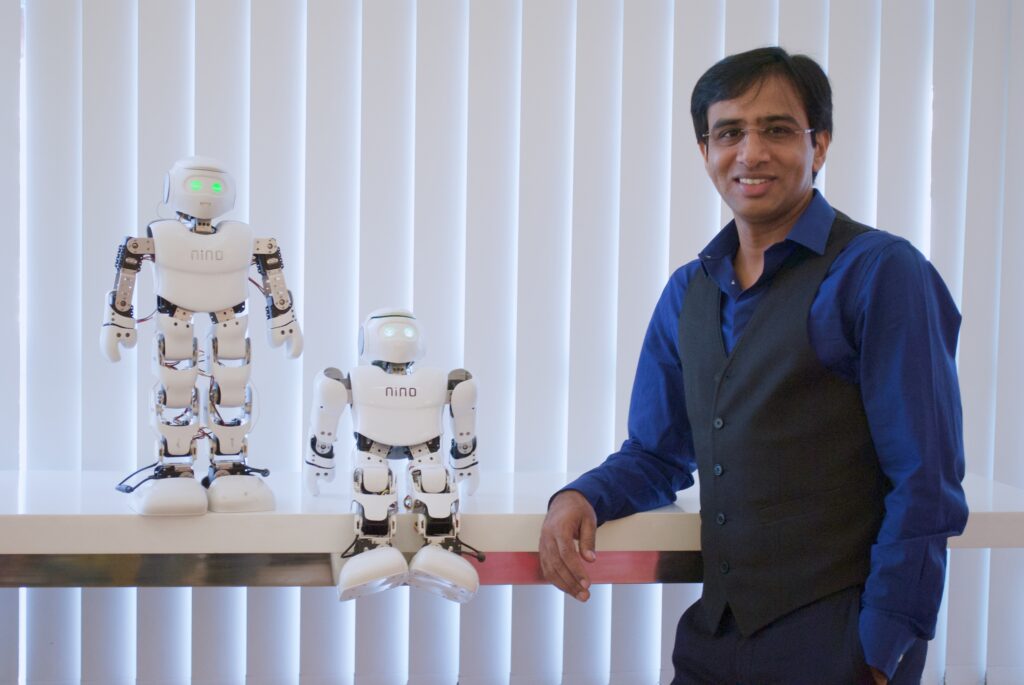
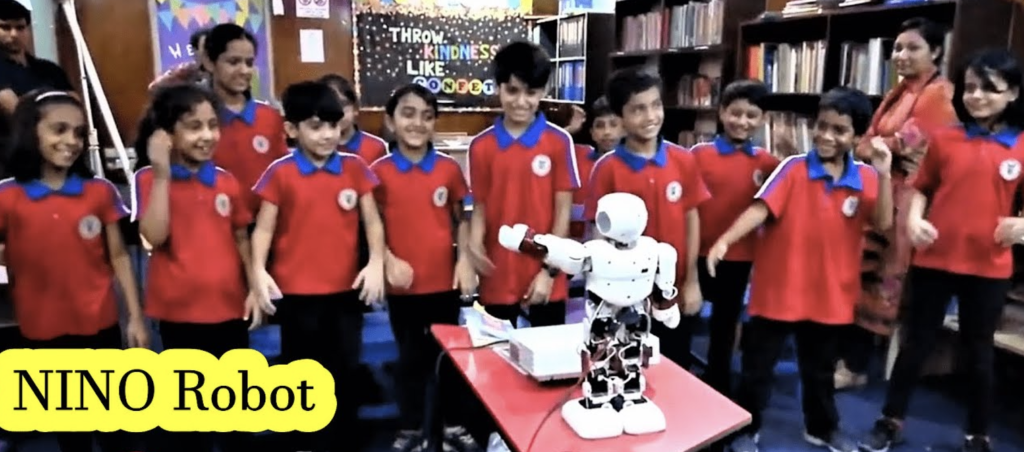
- Maitri: A humanoid robot designed to assist in healthcare settings, developed by Asimov Robotics.
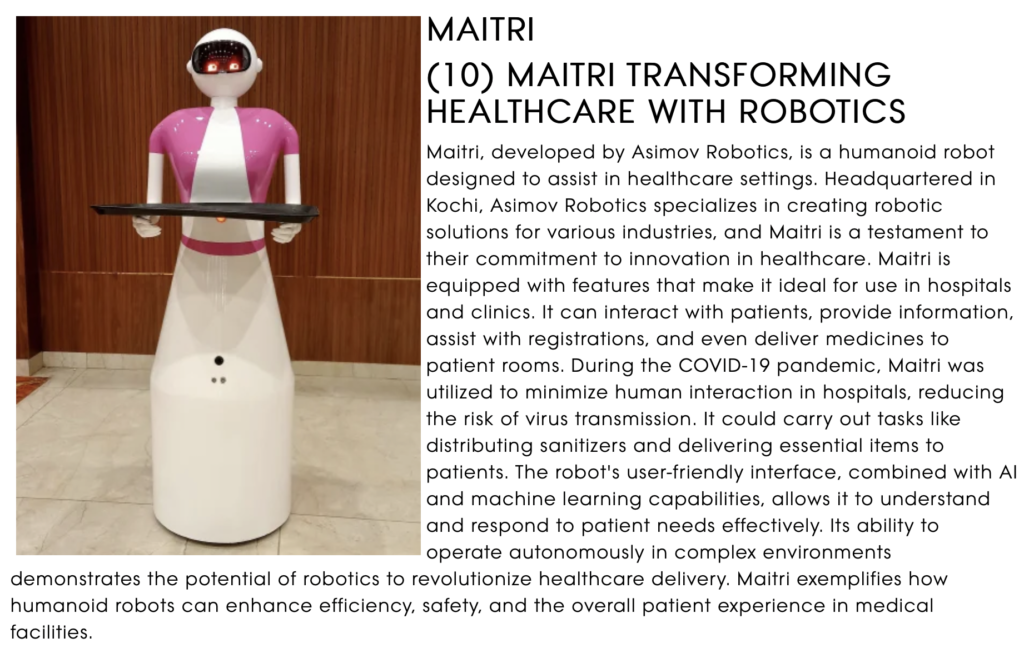
- Shalu (2020): A unique advancement, Shalu was built by a computer science teacher, Dinesh Patel, entirely from waste materials. Inspired by Sophia, Shalu can speak 47 languages, making it a valuable tool for education and demonstrating resourcefulness in robotics development
- Anushka (2024): Developed by students and professors at the Krishna Institute of Engineering and Technology (KIET), Anushka is a low-cost humanoid robot with a “beating heart.” Built partly from scrap materials, it features 3D-printed parts, flexible silicone skin, and intelligence inspired by Vedic principles. Anushka can understand and respond to queries in 61 languages with 50 hand gestures, and aims for applications beyond reception, including healthcare and consulting.
- AcYut (2008): Developed by students at BITS Pilani, AcYut was India’s first indigenously built humanoid robot. Initially constructed from scrap materials, it demonstrated capabilities like martial arts moves and dancing. Subsequent iterations, including AcYut 4 (2011), introduced autonomous interaction with surroundings, showcasing early advancements in vision sensors and image processing . AcYut has also competed in international robotics competitions like RoboCup and RoboGames.
- IRIS (2024): India’s first AI-powered humanoid teacher robot, IRIS, was developed by Makerlabs and deployed in a Kerala school. It uses generative AI to deliver educational content, featuring a 4-wheel chassis, 5 degrees of freedom, visual aids, games, quizzes, and a voice assistant for interactive learning.
- KARMI-Bot: Built by Asimov Robotics, KARMI-Bot is used in healthcare to deliver food and medical kits in isolation wards, minimizing direct contact between staff and infected patients. A variant, KARMI-CLEAN, uses UV light for disinfection.
- SSi Mantra: Developed by SS Innovations, SSi Mantra is a robotic surgeon designed for efficient and cost-effective surgeries. It has performed telesurgeries and its upgraded version, SSI Mantra 3, features a 3D HD headset and 4K vision for remote surgical monitoring.
- PuduBot: A service robot by Pudu Robotics, PuduBot is used for smart delivery services in hospitality and healthcare, making intelligent voice announcements and improving operational efficiency.
- BRABO: Developed by Tata Group’s TAL, BRABO is India’s first “Made in India” articulated robot. Launched in 2017, it performs industrial tasks like sorting, machine tending, picking, packing, sealing, and welding across various sectors.
Other mentions include robots like Pepper and Nao, which have been adopted by Indian institutions for educational and research purposes. Robots like TARA, developed by iHub Robotics, are leading the charge with advanced AI-powered interactions across industries.
Ref:
- India’s industrial transformation, starting in the 1990s, paved the way for a growing and innovative humanoid robotics market. [ https://mikekalil.com/blog/made-in-india-humanoid-robots/ ]
- Indian Humanoid Robots. [ https://www.ft-magazine.com/magazine/indian-humanoid-robots/ ]
- The Future of Humanoid Robots in India. [ https://thinkrobotics.com/blogs/learn/the-future-of-humanoid-robots-in-india?srsltid=AfmBOor7Q5QaVwcsIUyLPvOnqlVNeArpH3Z1yNGS3OYgTTGt6Xc_BRse ]
- Manav (robot). [ https://en.wikipedia.org/wiki/Manav_(robot)]
- Soccer Playing, 3D Printed MANAV Robot Debuts at IIT Mumbai TechFest. [ https://inside3dprinting.com/]
- Meet Mitra, India’s first 3D-printed humanoid robot. [ https://www.berylmenezes.com/]
- DRDO scientists working on humanoid robot for military missions to reduce risk for troops. [ https://m.economictimes.com/news/defence/drdo-scientists-working-on-humanoid-robot-for-military-missions-to-reduce-risk-for-troops/articleshow/121050767.cms]
- India’s first 3D-printed humanoid robot. [ https://timesofindia.indiatimes.com/etimes/trending/7-noteworthy-humanoid-robots-made-in-india/photostory/107303280.cms]
- Vyommitra. [ https://en.wikipedia.org/wiki/Vyommitra]
- Gaganyaan mission: Meet Vyommitra, the talking human robot that Isro will send to space. [ https://www.indiatoday.in/technology/news/story/gaganyaan-mission-meet-vyommitra-the-talking-human-robot-that-isro-will-send-to-space-1638024-2020-01-22]
- Humanoid robots are being adopted across various sectors in India, playing pivotal roles in transforming industries: [thinkrobotics.com/blogs/learn/the-future-of-humanoid-robots-in-india]
- AI and India: The Challenge of Minimising Risks and Maximising Benefits: [rsis.edu.sg/rsis-publication/idss/ip24027-ai-and-india-the-challenge-of-minimising-risks-and-maximising-benefits/]
- India: Is biometric data privacy at risk?: [dw.com/en/concerns-rise-over-a-new-law-that-lets-indian-police-record-prisoners-dna/a-63044478]
Also Read:
